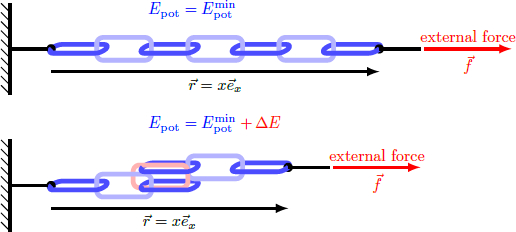Rubber Physics (Part 5)
We refer back to the model of a one-dimensional chain from part 4 .
The chain consists of chain links, each having a length of This time we assume that the first chain link is fixed, while on the end of the chain a force of acts. The outer force aligns the chain links in the direction so that the chain assumes its minimum potential energy when extended to its maximum length
How much energy does it take to flip a single chain link in the opposite direction?

This section requires Javascript.
You are seeing this because something didn't load right. We suggest you, (a) try
refreshing the page, (b) enabling javascript if it is disabled on your browser and,
finally, (c)
loading the
non-javascript version of this page
. We're sorry about the hassle.
The potential energy of the chain depends linear on the distance vector r = x e x : E pot = − r ⋅ f = − i = 1 ∑ N l i ⋅ f = − i = 1 ∑ N s i l f with the orientation vectors of the chain links, l i = s i l e x , and the corresponding sign, s i = ± 1 . If all signs s i are positive, the potential energy takes the value E pot = E pot min = − N l f If we flip a sigle chain link, we get E pot ⇒ Δ E = − ( N − 1 ) l f + N l f = − N l f + 2 l f = E pot min + Δ E = 2 l f